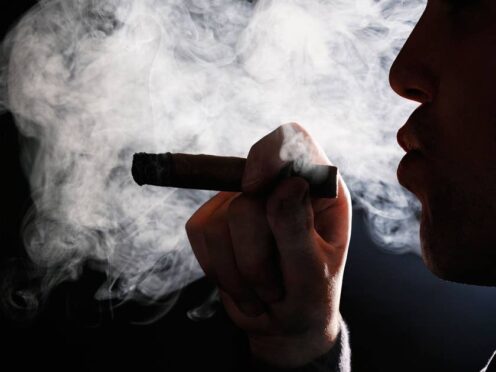The number of people smoking cigars and other non-cigarette tobacco products has soared over the last decade, a new study suggests.
Top cancer experts sounded the alarm after researchers found an almost five-fold increase in the proportion of people smoking cigars, cigarillos, pipes and shishas.
Cancer Research UK warned that all products containing tobacco are harmful and increase the risk of developing cancer.
Researchers from University College London (UCL) found that just 0.36% of the population were exclusive non-cigarette tobacco users in 2013, which rose to 1.68% in 2023.
This roughly equates to 151,200 people in 2013, rising to 772,800 last year, according to the study which has been published in the journal Nicotine and Tobacco Research.
This means that in 2022/23, around one in 10 smokers exclusively used non-cigarette tobacco, according to the study of almost 200,000 English adults.
Academics said that there was a “step level increase” in the use of these products at the start of the Covid-19 pandemic.
It’s never too late to quit smoking. When you stop smoking, there are almost immediate improvements to your health. You can quit smoking this No Smoking Day on Wednesday, 13 March.
Learn more here 👇https://t.co/643bc1bCiP pic.twitter.com/f0FEmIIEI5
— Royal Free London (@RoyalFreeNHS) March 4, 2024
Cancer Research UK said that this could have occurred because of concerns about cigarette smoking worsening coronavirus symptoms, so people may have switched to products they believed to be less harmful.
Financial difficulties may have also caused people to switch from cigarettes to cheaper options, it added.
Meanwhile, experts suggested that people who smoked menthol cigarettes may have switched to other products following the ban of menthol cigarettes in May 2020.
The authors of the study said that the rise in non-cigarette tobacco smokers from 2020 onwards was “most pronounced among younger adults” compared to older ages.
“This pattern of results may reflect greater exploration of different products among younger adults,” they wrote.
“Over the same period when exclusive non-cigarette tobacco smoking increased, there was also a marked increase in vaping among adolescents and young adults, which may have prompted experimentation with other nicotine products.”
The Government has pledged to create the “first smoke-free generation” and will introduce legislation so children born on or after 1 January 2009 will never be legally sold tobacco.
Smoking addicts people who then suffer multiple diseases including heart disease, cancers, dementia and stroke.
Vapes can help smokers quit, but should never be marketed to children.
The consultation on a smokefree generation is open. Please take part.https://t.co/UiesCf1gcK
— Professor Chris Whitty (@CMO_England) October 12, 2023
The charity has called on ministers to ensure that its new age of sale legislation will include all tobacco products.
Dr Ian Walker, Cancer Research UK’s executive director of policy, said: “Tobacco kills one person every five minutes in the UK. Research like this shows that the issue of smoking isn’t just about cigarettes – all tobacco products are harmful and cause cancer, no matter what form they come in.
“That’s why it’s crucial that the Government’s age of sale legislation applies to all tobacco products.
“If implemented, this policy will be a vital step towards creating a smokefree UK, preventing future generations from ever becoming addicted to tobacco.”
Smoking increases the risk of type 2 #diabetes by 30-40%. 🚭
Quit now and save yourself from future pain. ✅ pic.twitter.com/2maWZ29bf3
— World Health Organization (WHO) (@WHO) November 26, 2023
Dr Sarah Jackson, lead author of the paper and principal research fellow at UCL’s Institute of Epidemiology and Heath, said: “This 10-year-long study captures the shift in trends of non-cigarette tobacco use and paints a concerning picture.
“Although rates of cigarette smoking have fallen, our data show there has been a sharp rise in use of other smoked tobacco products, particularly among young people.
“It’s vital that smoking cessation services are adequately funded and available across the UK, so that the around 772,800 people who use non-cigarette tobacco products, and the millions who use cigarettes, are given the support they need to quit.”
Deborah Arnott, chief executive of the charity Action on Smoking and Health (Ash), said: “The largest single non-cigarette product category is cigars, which include cigarillos, a type of cigarette wrapped in cigar leaf.
“They’re just like cigarettes to smoke, but because they’re classed as cigars they’re not subject to plain packaging, there’s no ban on menthol flavours and pack sizes smaller than 20 are legal.
“A pack of 10 cigarillos can be bought for half the price of a pack of cigarettes, making them more attractive to price-sensitive young people.
“Since 2016 when plain packs legislation came into force sales volumes for cigars have grown by 90% and the majority of that growth will be due to cigarillos. This is a serious loophole in the legislation which needs to be fixed and fixed now.”
The Department of Health and Social Care has been approached for comment.
